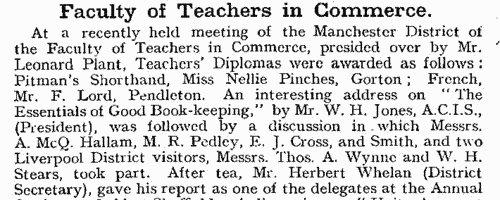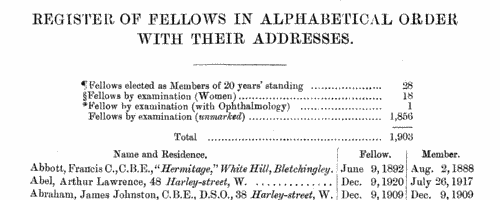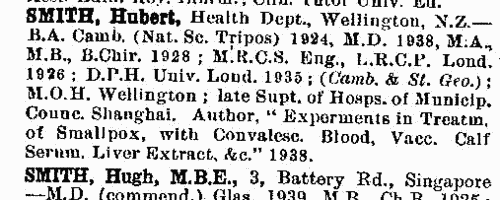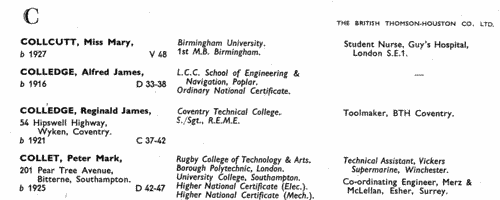Aiyar Surname Ancestry ResultsOur indexes 1000-1999 include entries for the spelling 'aiyar'. In the period you have requested, we have the following 18 records (displaying 11 to 18): Buy all | | | Get all 18 records to view, to save and print for £78.00 |
These sample scans are from the original record. You will get scans of the full pages or articles where the surname you searched for has been found. Your web browser may prevent the sample windows from opening; in this case please change your browser settings to allow pop-up windows from this site. Shorthand Writers
(1920-1921)
News and notices about Pitman's shorthand, with correspondence, advertisements &c.AIYAR. Cost: £6.00.  | Sample scan, click to enlarge

| Medical practitioners qualified in Britain or Ireland but living abroad
(1926)
The Medical Directory was split into several sections. The Practitioners Resident Abroad section covered all medical practitioners who, having qualified in Britain or Ireland or otherwise registered under the medical Acts of Great Britain and Ireland, were living abroad. Each year a schedule was sent to each doctor to be returned to the publishers, so as to keep the directory up to date. In the directory the doctor's name is given first, in bold, surname first, in capitals; then current address. Next are the qualifications; the italic abbreviations in parentheses following the qualifications indicate the medical school at which they were gained. Then there is a list of posts and honours within the profession, starting with those then current; previous posts are preceded by the word 'late'. Finally, brief details are given of any publications. AIYAR. Cost: £4.00.  | Sample scan, click to enlarge

| Surgeons
(1928)
The Royal College of Surgeons, established by royal charters, issued this calendar 1 August 1928, including official lists of all its fellows, members, licentiates and diplomates. The register of fellows gives full name (surname first) and address (in italics), with dates of admission as fellow and member. The list of members gives year of admission, full name (surname first) and town or country of residence. The lists of licentiates give year of admission and full name, but no indication of current address: entries of fellows of the college are prefixed with a double dagger, those of members with an asterisk. The lists of diplomates give year of admission and full name (surname first), with those diplomates who were neither members nor fellows of the college indicated with a dagger. This is the index to the members.AIYAR. Cost: £6.00.  | Sample scan, click to enlarge

| Graduate Electrical Engineers (Graduate I. E. E.)
(1939)
The Institution of Electrical Engineers was founded in 1871 under the name of The Society of Telegraph Engineers, and incorporated by royal charter in 1921. The list of members, corrected to 1 September 1939, gives the names and addresses of the various grades of members. Members (M. I. E. E.) and Associate Members (A. M. I. E. E.) were entitled to describe themselves as Chartered Electrical Engineers. Then there are the Associates (Associate I. E. E.), Companions (Companion I. E. E.), Graduates (Graduate I. E. E.) and Students (Student I. E. E.). The names are given in bold, surname first; before each name is the year of attaining that grade; and for the higher grades the year of each lower grade is also given, e. g. (G. 1931).AIYAR. Cost: £4.00.  | Sample scan, click to enlarge

| Student Electrical Engineers (Student I. E. E.)
(1939)
The Institution of Electrical Engineers was founded in 1871 under the name of The Society of Telegraph Engineers, and incorporated by royal charter in 1921. The list of members, corrected to 1 September 1939, gives the names and addresses of the various grades of members. Members (M. I. E. E.) and Associate Members (A. M. I. E. E.) were entitled to describe themselves as Chartered Electrical Engineers. Then there are the Associates (Associate I. E. E.), Companions (Companion I. E. E.), Graduates (Graduate I. E. E.) and Students (Student I. E. E.). The names are given in bold, surname first; before each name is the year of attaining that grade; and for the higher grades the year of each lower grade is also given, e. g. (G. 1931).AIYAR. Cost: £4.00.  | Sample scan, click to enlarge

| Doctors trained in Britain or Ireland but living abroad
(1948)
The Medical Directory was split into several sections. The Practitioners Resident Abroad section covered all medical practitioners who, having qualified in Britain or Ireland, were living abroad. Each year a schedule was sent to each doctor to be returned to the publishers, so as to keep the directory up to date. In the directory the doctor's name is given first, in bold, surname first, in capitals; then current address. Next are the qualifications; the italic abbreviations in parentheses following the qualifications indicate the medical school at which they were gained. Then there is a list of posts and honours within the profession, starting with those then current; previous posts are preceded by the word 'late'. Finally, brief details are given of any publications. Inclusion of names in the list did not imply a right to practise in the country of residence.AIYAR. Cost: £2.00.  | Sample scan, click to enlarge

| Chemists
(1950)
The Royal Institute of Chemistry was founded in 1877, and was open only to British subjects (and also, in due course, to citizens of the newly-created Republic of Ireland). Associates of the institute (A. R. I. C.) qualified either by studying chemistry, physics, mathematics and an optional science for the institute's examination (which insisted on a high standard of practical laboratory efficiency); or by obtaining good honours degrees or equivalent qualifications, with chemistry as principal subject, and having undergone training in allied sciences. Associates of at least three years' standing could then be admitted to the Fellowship (F. R. I. C.) either by taking a further examination in a special branch of chemistry, or by submitting the results of work or evidence of experience sufficient to justify the Council in granting exemption from such further examination. This register of fellows and associates, correct to 31 August 1950, contains 11,545 names, arranged alphabetically, surname first (in capitals), with qualifications, current address, telephone number, and (in italics) a brief description of present post in the chemical industry. Finally, year of admission as associate (A.) (and, where appropriate, fellow (F.) is given on the right-hand side. With this may appear the notation (x) for a fellow of the Chemical Society, (y) for a member of the Society of Chemical Industry, or (z) for a joint subscriber to all three chartered bodies.AIYAR. Cost: £4.00.  | Sample scan, click to enlarge

| Ex-Apprentices of British Thomson-Houston Company
(1951)
In 1938 the British Thomson-Houson Co Ltd of Rugby first published a 'record of those who embarked upon careers in the Engineering Industry by way of the British Thomson-Houston Company's Training Scheme': this enlarged edition was issued in September 1951, based on data verified up to December 1948, with subsequent corrections up to the time of printing. The company had been training apprentices since 1899.
The names of the deceased were printed in italics: the most vestigial entries in the volume simply give full name, and the years of apprenticeship; but most entries are much more comprehensive. The symbol 'w' indicates killed by enemy action.
In the first column full name is given in bold, surname first (in capitals), and then any title, decorations, academic qualifications in italics. Beneath that is current address (as of 1951); and then (to the left) year of birth, and (to the right) nature of course followed and years (e. g. 30-32 for 1930 to 1932) of commencement and completion. The abbreviations for the courses are: C, Craft Apprentice; Ch, Chemist Apprentice; Cl, Clerical Apprentice; D, Drawing Office Apprentice; E, Engineering Student Apprentice (Engineering Apprentice up to 1947); G, Graduate Apprentice (Student Apprentice up to 1947); (s), Special Course; T, Testers' Course; V, Vacation Student; W. O., Works Office Apprentice.
The second column gives particulars of academic training, war service, and miscellaneous information.
The third column gives positions held in the past (printed in italics) and present position (as of 1951) where known.AIYAR. Cost: £4.00.  | Sample scan, click to enlarge

|
 | 1 | 2 |
Research your ancestry, family history, genealogy and one-name study by direct access to original records and archives indexed by surname.
|










